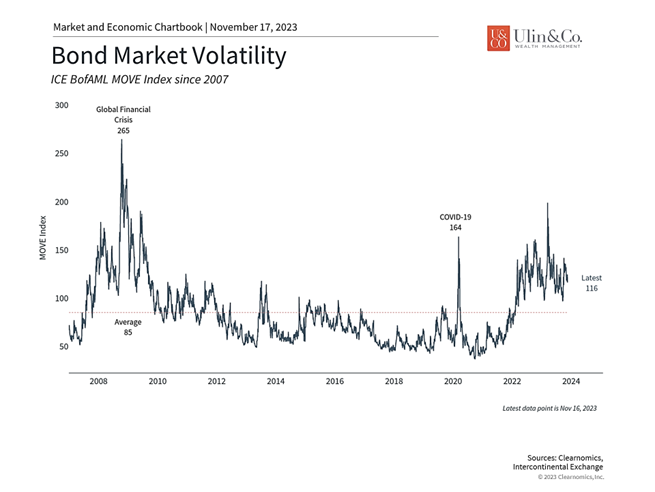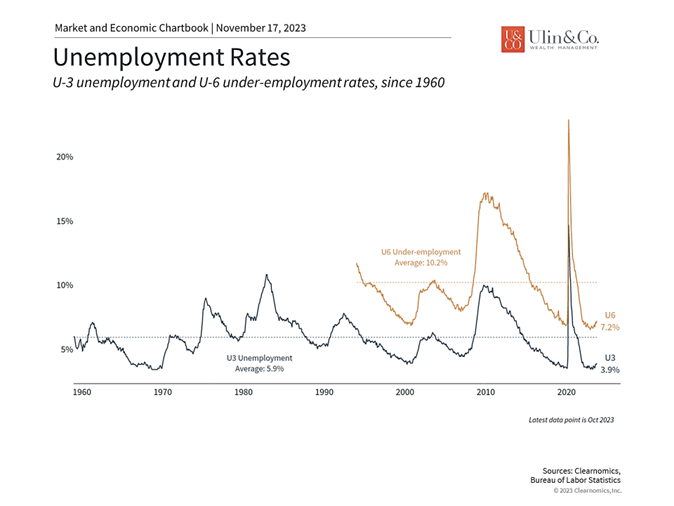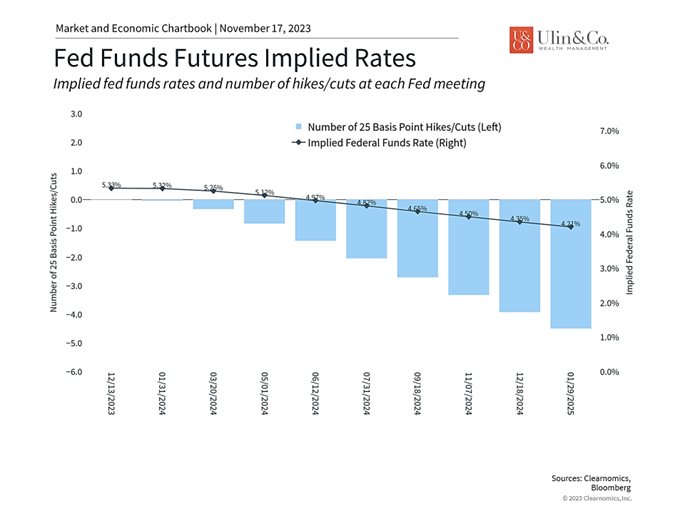The Psychology of Investing Through Headlines
-The good and bad news of Fed rate data points
From recent news of a shark attack or stock market correction, emotions of the crowd can run rampant and influence beachgoers to investors to be overcautious from diving into the ocean or the stock market, even if the long-term odds are in their favor.
Did your Crystal Ball Work in 2023? For Most Economists, it Did Not
Jon here. As we discussed this week at our Q4 workshop “Beyond the Headlines” for the South Florida IBM QCC & Alumni Association, maintaining a calm, patient mindset through ominous headlines and market events can be difficult but pay off over time for long term investors. Just at the top of this year, 70% of economists forecasted a 70% chance of a recession and crash that never transpired despite a ton of major geopolitical and economic events that transpired.
In fact, most experts and investors alike were surprised to the upside of consumer spending, GDP and market resilience through record high interest rates and inflation. Still half of the headlines going into 2024 will most likely continue to focus on what doom and gloom factors may arise, as bad news sells.
Recency Bias
Recency bias, also known as availability bias, is a cognitive bias that refers to the tendency of individuals to rely too heavily on recent information when making decisions. This bias can significantly impact investors, particularly in the realm of personal finance and long-term investing for retirement and other goals.
In the context of investing, recency bias occurs when individuals give more weight to recent events and news , often overlooking historical data or the broader market trends. This bias can be particularly pronounced in today’s fast-paced world, where news is constantly at our fingertips right through various media channels.
One aspect of recency bias that affects investors is the temptation to take immediate action based on recent, often alarming, headlines. For instance, if there is a sudden market correction or an ominous headline on a war, bank crash, or the debt ceiling, investors might be inclined to make impulsive decisions, such as selling off their investments or changing their portfolio allocations. This knee-jerk reaction based on fear is driven by the recency bias, where the most recent information overshadows long-term historical trends and data.
Taking action in the short term based on ominous news can harm long-term returns for several reasons. First, markets are inherently volatile, and short-term fluctuations are common. Reacting to every piece of negative news can lead to frequent buying and selling, resulting in under performance. Second, many of the insurance, alternative and other hedging products to stocks often sold by advisors come with additional costs and risks. Moreover, the emotional toll of constantly reacting to short-term events can contribute to stress and anxiety, which can further cloud judgment.
Working with an experienced financial advisor and wealth manager can help you to better navigate the news, data points and trends, while helping to execute disciplined, strategic allocated portfolio and holistic plan based on your risk tolerance, as well as help you to stay on course through headline market volatility.
Volatility is the Price of Admission
There’s a common saying among investors that markets take the stairs up and the elevator down. This is because the long-term trends that drive markets higher tend to be slow moving and compound over time, whereas the events that create short-term panic tend to be sudden and unexpected. At the same time, history shows that even new market lows tend to be higher than previous peaks.
In other words, markets often take the stairs up several floors before riding the elevator down one or two levels. For long-term investors, understanding this dynamic in the current environment is critical to staying focused on important financial goals.
The S&P 500 has seen a total of 103 market corrections in history, including the current one triggered in October. A few lasted as few as four days, as was the case in 1932, 1987 and in 2008, according to Dow Jones Market Data. Some may last a month or longer. Regardless, market volatility is part of the investing process. Consider the following few factors including unemployment and Fed rate hikes or cuts that will be front and center of the headlines for Q4.
Bond market volatility has been elevated

The recent market correction only pulled the S&P 500 back to levels last reached in May before then spurring the strongest rally of the year during which the market gained 5.9%. This is because investors feared the worst when rates jumped in October before new data showed that the backdrop is more balanced than expected – one in which inflation is slowing and economic growth is steady but decelerating enough to appease Fed policymakers. Markets often need time to adjust to these dynamics which naturally causes asset prices to swing.
While investors often focus on stock market volatility, using measures such as the VIX index, the volatility of interest rates and the bond market has been far more severe since the beginning of 2022. The 10-year Treasury yield, for instance, has made multiple roundtrips within a range of 4.5% to 5% since September. The accompanying chart above shows the MOVE index of bond market volatility which has been elevated for over a year and a half. Fortunately, recent economic data have led interest rates to fall once again, calming markets.
The job market is showing signs of softening

One reason for this is the recent jobs report for October which showed that hiring slowed. The economy added 150,000 new jobs over the month which is less than the 180,000 that economists had expected. This was also a sharp decline from September’s 297,000 new jobs, due in no small part to a drop in manufacturing employment due to factory strikes. Unemployment increased slightly from 3.8% to 3.9% while the labor force participation rate, which measures the percentage of the working age population either working or actively looking for work, declined slightly to 62.7%.
While these figures represent a slowdown in the job market in October, it’s important to understand how they fit into the bigger picture. First, investors should never make decisions based on only a single month’s numbers, whether it’s the jobs report, the Consumer Price Index, or GDP. Not only are these figures subject to change but they are also only estimates with wide margins of error.
Second, and more importantly, investors have been anticipating a slowdown in the labor market in response to tighter monetary policy by the Fed. The softening of an otherwise strong labor market coupled with improvements in inflation represent the Goldilocks situation investors have been hoping for. A “soft landing” means that the Fed can pause its rate hikes and, as price pressures decline, possibly consider cutting rates over the next couple of years. Unlike in 2022 when the Fed had to raise rates rapidly, the possible end of the tightening cycle will likely create more stability and certainty for investors. In the ideal scenario, the gap between reality and expectations could shrink as the macroeconomic shocks of the past few years continue to fade.
Markets do not expect the Fed to raise rates again

Holding rates steady is precisely what the Fed did again at its November meeting. The Fed recognized that there have been important improvements to the inflation story while the overall economy has been healthier than expected. A softer labor market reduces the risk that inflation could surge unexpectedly, and unemployment is approaching the Fed’s 4% forecast for the end of the year. The Fed’s ideal situation is that interest rates remain high across the yield curve to keep the economy in check without the need for additional rate hikes.
This is not to say that market volatility is behind us – it never is, after all. On the contrary, it highlights that markets and investors often get ahead of themselves whether it’s due to inflation, the Fed, financial stability in China, Washington politics, or dozens of other factors. In all of these cases, it’s more important for investors to understand the bigger picture than try to react to every new headline.
The bottom line? Investors should maintain a long-term perspective rooted in economic and market trends. Doing so is still the best way to increase the odds of achieving financial goals.
For more information on our firm or to request a complementary investment and retirement check-up with Jon W. Ulin, CFP®, please call us at (561) 210-7887 or email jon.ulin@ulinwealth.com. Get Started Today: Contact Us.
Note: Diversification does not ensure a profit or guarantee against loss. You cannot invest directly in an index.
Information provided on tax and estate planning is not intended to be a substitute for specific individualized tax or legal advice. We suggest that you discuss your specific situation with a qualified tax or legal advisor.
You cannot invest directly in an index. Past performance is no guarantee of future returns. Diversification does not ensure a profit or guarantee against loss. All examples and charts shown are hypothetical used for illustrative purposes only and do not represent any actual investment. The information given herein is taken from sources that IFP Advisors, LLC, dba Independent Financial Partners (IFP), and it advisors believe to be reliable, but it is not guaranteed by us as to accuracy or completeness. This is for informational purposes only and in no event should be construed as an offer to sell or solicitation of an offer to buy any securities or products. Please consult your tax and/or legal advisor before implementing any tax and/or legal related strategies mentioned in this publication as IFP does not provide tax and/or legal advice. Opinions expressed are subject to change without notice and do not take into account the particular investment objectives, financial situation, or needs of individual investors.




